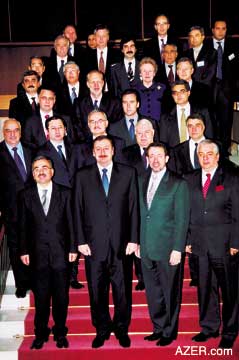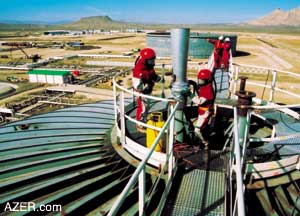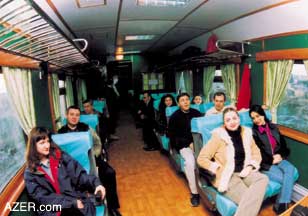|

Spring 2004 (12.1)
Pages
130-132
BP Current Developments
Baku-Tbilisi-Ceyhan
Pipeline - BTC Gets Funded
In early February, the
official signing ceremony took place Gulustan Palace in Baku
to mark the completion of agreements covering third party financing
for the BTC construction of the pipeline project. Government
representatives from Azerbaijan, Georgia and Turkey, along with
representatives from the BTC lender group were present.
The financing package included 208 finance documents, with over
17,000 signatures from 78 different parties. It represents a
major milestone in the implementation of the financing arrangements
for the pipeline, which will cost $2.95 billion to construct
($3.6 billion total project cost including linefill and loan
interest during construction).
Approximately 30 percent of BTC costs are being funded by equity
contributions, while the remaining 70 percent are being provided
in the form of financing by third parties. The BTC partners have
already contributed $1 billion. The total debt committed is $2.6
billion, thus completing the funding for the project.
The group that will provide loans, export credits and risk insurance
to BTC is comprised of multilateral lending agencies, the Export
Credit Agencies and Political Risk Insurers of seven countries,
a syndicate of 15 commercial banks and loans provided by BP,
Statoil, Total and ConocoPhillips, as senior sponsor lenders.
Financing agreements came after more than two years of far-reaching
monitoring and scrutiny of the project's environmental and social
impact, as well as a thorough public consultation process.
Below: The signing ceremony of the BTC project
finance agreements in the Gulustan Palace in Baku. February 3,
2004.
  BTC Construction Progresses BTC Construction Progresses
To date, more than 50 per cent of the pipeline construction is
complete. Some 945 km of the right of way (ROW) has been prepared,
786 km of pipe strung, 710 km of pipe welded, 332 km of the pipeline
corridor trenched, 292 km of pipe lowered-in and 268 km already
backfilled. These days, construction activities are being carried
out at 17 sites in the three countries.
The pipeline employs more than12,000 people along its entire
route from Baku to Ceyhan (Turkey). BTC together with the South
Caucasus Pipeline (SCP) will spend some $30 million (including
$5.5 million already awarded in Azerbaijan) on community and
environmental investment between now and 2006 in Azerbaijan,
Georgia and Turkey.
Ganja-Baku Rail
Service
To reduce the potential risk to road traffic accidents due to
the large number of additional personnel BTC would require in
2004, BTC has completely refurbished a railway carriage and dedicated
it to transporting the project personnel, using the existing
Baku to Ganja rail service. The final design comprises two seating
compartments and one working area with a total capacity of 38
seats.
In both compartments, a television screen has been installed
to facilitate the safety briefings and showing of training videos
in English and Azeri to save time for new arrivals to receive
safety inductions en route.
Azeri Project
The jacket for the Central Azeri production, drilling and quarters
platform sailed away early March from the Baku Deepwater Jackets
Factory yard to be installed at its permanent location in the
Azeri field.
The jacket is the largest structure ever to be installed in the
Caspian Sea. It has been fully assembled here using local construction
infrastructure and SOCAR facilities. The total weight of the
jacket is 14,130 tons including the flotation tanks. It is 143
meters high, and will be installed at a water depth of 120 meters.
The jacket has 12 piles, each 146 meters long, weighing 8,100
tons.
The installation of the jacket will use a number of SOCAR/KMNF
vessels including the two principal installation vessels Derrick
Barge Azerbaijan (DBA) and the STB-1 launch barge. The DBA has
been extensively upgraded to undertake the installation work,
including main crane refurbishment, upgraded mooring system and
helideck. The STB-1 barge, which was originally designed to transport
and launch jackets up to 18,000 tons, also underwent an extensive
refurbishment and deck-strengthening program, which required
1,300 tons of steelwork. Installation is expected to take from
35 days to 60 days to complete.
Nearly 200 personnel are involved in the jacket installation,
more than 50 percent of them being Azerbaijan nationals. The
jacket transportation and offshore installation work is being
done by Saipem.
  Left: President Ilham Aliyev at the signing ceremony
for the BTC project finance agreements, February 3, 2004, Baku. Left: President Ilham Aliyev at the signing ceremony
for the BTC project finance agreements, February 3, 2004, Baku.
Subsea Gas Pipeline
In March AIOC also completed the laying of the 28" subsea
gas pipeline for the ACG (Azeri-Chirag-Gunashli) Project. A 30"
subsea oil pipeline had already been completed in December 2003.
This second pipeline completes the installation of the offshore
pipelines required for "First Oil".
The 28" pipeline extends 186 kilometers from the Sangachal
Terminal to the Central Azeri Production, Drilling and Quarters
Platform location. It is the second trunk line in a series of
three for the ACG project. The second 30" subsea oil pipeline
is scheduled to be laid in 2005 for production from West and
East Azeri.
The pipeline was laid by the pipe-lay barge Israfil Huseynov
in water depths up to 200metres with an average lay-rate of about
2.5 kilometers per day.
The pipe sections came from Japan. They were coated for corrosion
and concrete weight coated locally in the new Eupec Azerbaijan
Pipe-coatings facility in Baku, and were then safely loaded out
from the new Quayside facilities in Baku Bay.
The first East Azeri pre-drill well was spudded early February,
which marked the commencement of the EA pre-drilling program.
The East Azeri pre-drilling program currently consists of six
wells, and their design depth will range from 4,000 m to 5,300
m. The programmed well timings range from 31 days per well to
89 days, depending upon specific work required at each well.
EA pre-drilling program will take eleven months.
The drilling contractor for the Azeri pre-drilling program is
the Caspian Drilling Company, a joint venture between SOCAR and
Global Santa Fe.
Safety Achievements
In February the AIOC and Tekfen/Azfen, the main contractor for
the Sangachal Terminal Expansion Program (STEP), achieved the
milestone of 10 million man-hours without a day away from work.
Another BP-operated facility, the Western Route Export Pipeline
(WREP) from Baku to Supsa also has demonstrated remarkable safety
performance since the beginning of its operations five years
ago. The rigorous health and safety culture established by the
pipeline staff has enabled them to achieve five years without
a single day away from work case (2.5 million man hours).
Below: (Left) Sangachal Terminal Expansion
project activities, Spring 2004. Right: Refurbished railway carriage
to transport BTC projects personnel between Baku and Ganja. Spring
2004.
 |
 |
Shah Deniz
In late February Shah Deniz spudded the third pre-drilling development
well. This completes the Shah Deniz Stage 1 Pre-drilling Program.
The well is being drilled from the existing drilling template
to a location that is near the fields crest, with a drilling
step-out of 2.3 km, making this the most difficult of the pre-drill
wells. The water depth at the template location is approximately
101 meters. The design depth of the well is 6,285 meters and
will take approximately 165 days to drill and suspend.
This follows the successful completion of the second pre-drilling
well SDA-02, which reached a total depth of 6,540 meters on January
1, 2004.
Significant progress has been
made for Shah Deniz Stage 1 in the construction yards both in
Baku and other parts of the world. The pace of fabrication is
now at its peak.
In Norway's Nymo Yard the team is ready to start the drilling
equipment commissioning to make sure it is mechanically complete
and functions well.
In Singapore, work is more than 45 percent complete, and work
on the TPG500 hull strips is in full swing. The completed hull
strips and the drilling equipment will begin their voyage to
Baku later this summer.
Construction of the Shah Deniz section has already begun in the
Sangachal Terminal Expansion area on the roads. Drainage infrastructure
and the foundation has been laid for the Hot Oil Heater.
The South Caucasus pipeline (SCP) project progress is on track.
The first of the dual pipelays with BTC at river crossings have
been completed and the initial shipments of linepipe have been
received and stockpiled.
Shah Deniz Grants
The Shah Deniz Community Investment Program in Azerbaijan is
aimed at making a positive contribution to the lives of the communities
living near the project areas in the Garadag district, Zykh and
Bibi Heybet. An estimated 120,000 residents live in these areas.
BP and its partners in Shah Deniz will spend $1.78 million in
community investment between now and the end of 2006.
In Azerbaijan grants for the implementation of the Shah Deniz
Community Investment Program have been awarded to the Foundation
for International Community Assistance (FINCA Azerbaijan) for
micro-finance services, Umid Humanitarian and Social Support
Center (Umid), a national NGO for community development and income
generation, and World Vision for community development, microfinance
and income generation.
The total value of the above CIP grants is $1.5 million, over
the program duration, which ends in 2006.
New Sports Facility
In March, AIOC inaugurated the newly rehabilitated sports facility
for Secondary School No. 222 in Sangachal. The project started
in November 2003 and was completed in February this year. The
facility rehabilitation work included leveling of 7,500 square
meters of sport ground area, construction of a new fence, installation
of new volleyball and basketball grounds, rehabilitation of the
existing football ground and some other related work.
Back to Index AI 12.1 (Spring
2004)
AI Home
| Search | Magazine
Choice
| Topics
| AI Store | Contact us
Other Web sites
created by Azerbaijan International
AZgallery.org | AZERI.org | HAJIBEYOV.com
|




